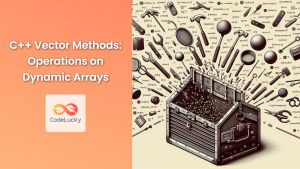C++ has always been known for its power and flexibility, but with the introduction of the range-based for loop in C++11, it has become even more developer-friendly. This feature simplifies iteration over containers and arrays, making your code more readable and less prone to errors. In this comprehensive guide, we'll dive deep into the world of range-based for loops, exploring their syntax, benefits, and various use cases.
Understanding the Range-Based For Loop
The range-based for loop, also known as the "for-each" loop, provides a concise and intuitive way to iterate over elements in a container or array. Its syntax is straightforward:
for (element_declaration : range_expression) {
// loop body
}
Here, element_declaration is the variable that will hold each element of the container during iteration, and range_expression is the container or array you want to iterate over.
🚀 Benefits of Range-Based For Loops
- Simplicity: Reduces boilerplate code, making your loops more concise and readable.
- Safety: Eliminates common errors associated with traditional for loops, such as off-by-one errors.
- Versatility: Works with a wide range of containers and arrays.
- Performance: Can be as efficient as traditional loops, especially with compiler optimizations.
Basic Usage with Different Containers
Let's explore how range-based for loops work with various C++ containers.
🔢 Arrays
#include <iostream>
int main() {
int numbers[] = {1, 2, 3, 4, 5};
for (int num : numbers) {
std::cout << num << " ";
}
std::cout << std::endl;
return 0;
}
Output:
1 2 3 4 5
In this example, we iterate over a simple integer array. The loop automatically handles the array bounds, preventing potential out-of-bounds errors.
📚 Vectors
#include <iostream>
#include <vector>
int main() {
std::vector<std::string> fruits = {"apple", "banana", "cherry"};
for (const std::string& fruit : fruits) {
std::cout << fruit << " ";
}
std::cout << std::endl;
return 0;
}
Output:
apple banana cherry
Notice how we use const std::string& to avoid unnecessary copying of string objects.
🗺️ Maps
#include <iostream>
#include <map>
int main() {
std::map<std::string, int> ages = {
{"Alice", 25},
{"Bob", 30},
{"Charlie", 35}
};
for (const auto& pair : ages) {
std::cout << pair.first << " is " << pair.second << " years old." << std::endl;
}
return 0;
}
Output:
Alice is 25 years old.
Bob is 30 years old.
Charlie is 35 years old.
Here, we use auto to automatically deduce the type of each key-value pair in the map.
Advanced Techniques and Best Practices
🔄 Modifying Elements
If you need to modify elements while iterating, you can use a reference:
#include <iostream>
#include <vector>
int main() {
std::vector<int> numbers = {1, 2, 3, 4, 5};
for (int& num : numbers) {
num *= 2;
}
for (int num : numbers) {
std::cout << num << " ";
}
std::cout << std::endl;
return 0;
}
Output:
2 4 6 8 10
🏃♂️ Using auto for Type Deduction
The auto keyword can make your code more flexible and easier to maintain:
#include <iostream>
#include <vector>
#include <string>
int main() {
std::vector<std::string> words = {"Hello", "World", "C++"};
for (const auto& word : words) {
std::cout << word << " ";
}
std::cout << std::endl;
return 0;
}
Output:
Hello World C++
🎭 Structured Bindings with C++17
C++17 introduced structured bindings, which work great with range-based for loops:
#include <iostream>
#include <map>
int main() {
std::map<std::string, int> scores = {
{"Alice", 95},
{"Bob", 87},
{"Charlie", 92}
};
for (const auto& [name, score] : scores) {
std::cout << name << " scored " << score << " points." << std::endl;
}
return 0;
}
Output:
Alice scored 95 points.
Bob scored 87 points.
Charlie scored 92 points.
This syntax provides a more intuitive way to work with key-value pairs.
🧪 Performance Considerations
While range-based for loops are generally as efficient as traditional loops, there are some scenarios where performance can be optimized:
Using References
When dealing with large objects, use references to avoid unnecessary copying:
struct LargeObject {
// Imagine this has a lot of data
int data[1000];
};
std::vector<LargeObject> objects(100);
// Good: Uses reference
for (const auto& obj : objects) {
// Process obj
}
// Bad: Copies each object
for (auto obj : objects) {
// Process obj
}
Avoiding Temporary Objects
Be cautious when using range-based for loops with functions that return temporary objects:
std::vector<int> getNumbers() {
return {1, 2, 3, 4, 5};
}
// Inefficient: Creates a new vector each iteration
for (int num : getNumbers()) {
std::cout << num << " ";
}
// Better: Store the result first
auto numbers = getNumbers();
for (int num : numbers) {
std::cout << num << " ";
}
🎨 Custom Types and Range-Based For Loops
To make your custom types work with range-based for loops, you need to provide begin() and end() functions:
#include <iostream>
class NumberSequence {
private:
int start;
int end;
public:
NumberSequence(int s, int e) : start(s), end(e) {}
class Iterator {
private:
int current;
public:
Iterator(int value) : current(value) {}
int operator*() const { return current; }
Iterator& operator++() { ++current; return *this; }
bool operator!=(const Iterator& other) const { return current != other.current; }
};
Iterator begin() const { return Iterator(start); }
Iterator end() const { return Iterator(end + 1); }
};
int main() {
NumberSequence seq(1, 5);
for (int num : seq) {
std::cout << num << " ";
}
std::cout << std::endl;
return 0;
}
Output:
1 2 3 4 5
This example demonstrates how to create a custom iterable type that works seamlessly with range-based for loops.
🚫 Common Pitfalls and How to Avoid Them
Modifying the Container While Iterating
Modifying a container while iterating over it can lead to undefined behavior:
std::vector<int> numbers = {1, 2, 3, 4, 5};
// Dangerous: May lead to undefined behavior
for (int num : numbers) {
if (num % 2 == 0) {
numbers.push_back(num * 2);
}
}
Instead, create a new container for modifications:
std::vector<int> numbers = {1, 2, 3, 4, 5};
std::vector<int> newNumbers;
for (int num : numbers) {
newNumbers.push_back(num);
if (num % 2 == 0) {
newNumbers.push_back(num * 2);
}
}
Using Range-Based For Loops with Temporary Objects
Be cautious when using range-based for loops with temporary objects:
// Dangerous: The temporary vector is destroyed after each iteration
for (int num : std::vector<int>{1, 2, 3, 4, 5}) {
std::cout << num << " ";
}
Instead, store the temporary object in a named variable:
auto numbers = std::vector<int>{1, 2, 3, 4, 5};
for (int num : numbers) {
std::cout << num << " ";
}
🔍 Comparing Range-Based For Loops with Traditional Loops
Let's compare range-based for loops with traditional for loops to highlight the benefits:
#include <iostream>
#include <vector>
int main() {
std::vector<int> numbers = {1, 2, 3, 4, 5};
// Traditional for loop
std::cout << "Traditional for loop: ";
for (size_t i = 0; i < numbers.size(); ++i) {
std::cout << numbers[i] << " ";
}
std::cout << std::endl;
// Range-based for loop
std::cout << "Range-based for loop: ";
for (int num : numbers) {
std::cout << num << " ";
}
std::cout << std::endl;
return 0;
}
Output:
Traditional for loop: 1 2 3 4 5
Range-based for loop: 1 2 3 4 5
The range-based for loop is clearly more concise and less prone to errors like off-by-one mistakes.
🌟 Real-World Examples
Let's look at some practical examples where range-based for loops shine:
📊 Calculating Average
#include <iostream>
#include <vector>
#include <numeric>
double calculateAverage(const std::vector<double>& values) {
double sum = 0.0;
for (double value : values) {
sum += value;
}
return sum / values.size();
}
int main() {
std::vector<double> temperatures = {22.5, 23.1, 24.0, 23.4, 22.8};
std::cout << "Average temperature: " << calculateAverage(temperatures) << "°C" << std::endl;
return 0;
}
Output:
Average temperature: 23.16°C
🔤 String Manipulation
#include <iostream>
#include <string>
#include <cctype>
std::string capitalizeWords(const std::string& sentence) {
std::string result = sentence;
bool newWord = true;
for (char& c : result) {
if (std::isalpha(c)) {
if (newWord) {
c = std::toupper(c);
newWord = false;
}
} else {
newWord = true;
}
}
return result;
}
int main() {
std::string sentence = "welcome to c++ programming";
std::cout << "Original: " << sentence << std::endl;
std::cout << "Capitalized: " << capitalizeWords(sentence) << std::endl;
return 0;
}
Output:
Original: welcome to c++ programming
Capitalized: Welcome To C++ Programming
🎓 Conclusion
Range-based for loops in C++ offer a powerful and intuitive way to iterate over containers and arrays. They simplify your code, reduce errors, and work seamlessly with a wide variety of data structures. By understanding the nuances and best practices we've covered, you can write more elegant and efficient C++ code.
Remember these key points:
- Use references to avoid unnecessary copying of large objects.
- Leverage
autofor type deduction to make your code more flexible. - Be cautious when modifying containers during iteration.
- Create custom iterators for your own types to work with range-based for loops.
As you continue your C++ journey, make range-based for loops a regular part of your coding toolkit. They're not just a syntactic sugar – they represent a more modern, safer, and often more readable approach to iteration in C++.
Happy coding, and may your loops always be in range! 🚀🔄
- Understanding the Range-Based For Loop
- 🚀 Benefits of Range-Based For Loops
- Basic Usage with Different Containers
- Advanced Techniques and Best Practices
- 🧪 Performance Considerations
- 🎨 Custom Types and Range-Based For Loops
- 🚫 Common Pitfalls and How to Avoid Them
- 🔍 Comparing Range-Based For Loops with Traditional Loops
- 🌟 Real-World Examples
- 🎓 Conclusion















